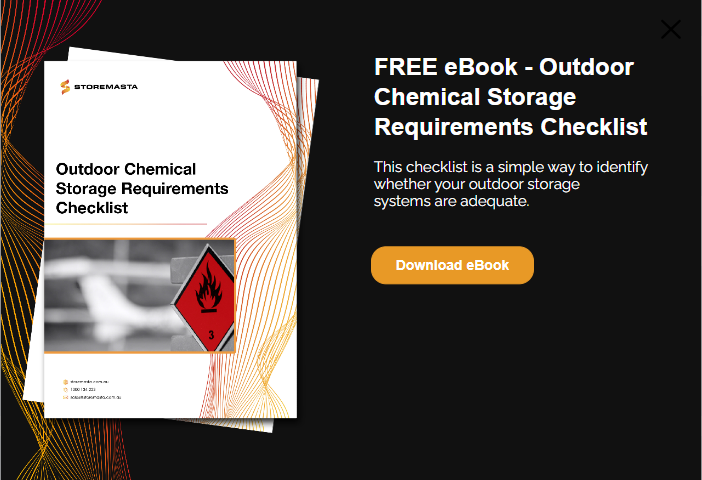When storing dangerous goods outdoors, there are specific risks you must control if you are to ensure a safe working environment for your people. If your organisation carries any type of Class 6.1 Toxic Substances, those risks can include asphyxiation, acute illness and even fatalities. Toxic chemicals are often used in everyday products such as pesticides, cleaning agents and disinfectants. And while some organisations regularly use toxic substances, such as sodium azide, sodium cyanide, mercuric chloride and methylene chloride, there are serious risks associated with handling and storing toxic substances. this blog, we’ll be looking at the specific hazards associated with this chemical class — and how you can achieve compliance with an outdoor toxic substances store.
Defining Toxic Substances
The Australian Dangerous Goods Code (ADG code) provides definitions for dangerous goods classes, such as toxic substances. The ADG Code explains Class 6.1 Toxic Substances are:
“substances liable either to cause death or serious injury or to harm human health if swallowed or inhaled or by skin contact.”
There are 3 packing groups (PG) of toxic substances — and each present a different degree of danger. PG 1 is the group classed as being the most toxic, with substances in PG III being classes as having a relatively low toxicity.
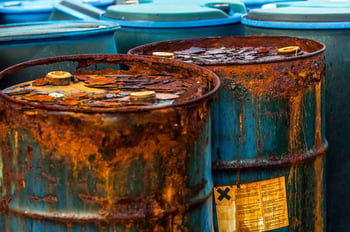
Class 6.1 Toxic Substances are defined as chemicals that can cause serious illness or death.
Key Risks Associated With Toxic Substances
The key risks when handling and storing toxic substances are the potential for human harm and environmental damage. Toxic substances can cause serious issues if chemical leaks or spills occur. Harm can also happen when chemicals containers are accidently dropped, or substances are splashed into the eyes or on the skin of workers.
Human Harm
There are three ways that toxic substances can enter the human body and cause damage. These methods include the inhalation of toxic vapours, skin absorption through contact with the liquid, and the ingestion of the toxic substance.
When any organisation carries any type of toxic substance, they must ensure that their staff are aware of the hazards — and provide them with the procedures and control measures to maintain workplace health and safety.

Class 6.1 Toxic Substances pose serious health risks to the people that work with them.
Environmental Damage
Toxic substances also pose a serious risk to the environment. Chemical leaks and spills, if not properly managed and cleaned-up, can seep into soil, enter waterways and affect the environment and wildlife. When storing toxic substances in an outdoor location, you must have adequate spill control systems to avoid such an incident.
Indoor or Outdoor Storage For Class 6.1 Substances?
When keeping larger quantities of toxic substances in the workplace, it is often a more convenient option to store these hazardous chemicals outdoors.
The Standard which details the storage requirements applicable for Class 6.1 dangerous goods is AS NZS 4452:1997 – The storage and handling of toxic substances.
AS NZS 4452:1997 explains that there are maximum storage quantities that apply to the indoor storage of toxic substances in safety cabinets. The maximum amount of toxic substances that can be kept within a single cabinet should not exceed 250 L/kg. Furthermore, no more than 50 L/kg within that quantity should be from PG II, and no more than 25 L/kg from PG I.
If you’re storing more than 250 L/kg of toxic substances in your workplace, you are required to store these chemicals outdoors.
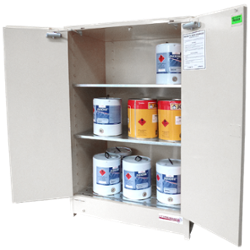 Indoor toxic substance cabinets are subject to the maximum capacity requirements set out in the Australian Standards.
Indoor toxic substance cabinets are subject to the maximum capacity requirements set out in the Australian Standards.
Outdoor Storage Requirements
The Standard also details the construction requirements for outdoor stores of toxic substances. These requirements can be found in Section 4.4 General requirements for package stores.
Outdoor toxic substance stores may be a freestanding, roofed structure or building, an outdoor storage area with a security fence, or a roofed structure or room which is attached to an external wall of your building. Due to the convenience and cost-effectiveness of chemical storage containers, toxic substances are often stored outdoors in this type of package store.
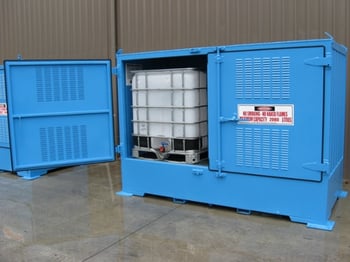
Outdoor toxic substance stores should feature including non-combustible construction materials, adequate spill containment and ventilation.
General construction requirements for toxic substances are extensive and include:
- Constructed with walls, roof sheeting and main structural elements that are non-combustible and resistant to attack by the toxic substances
- Spill containment system to contain or divert a chemical spill
- Adequate ventilate
- Secured against unauthorised entry
- Provision for safety shower, eyewash facilities and water for hand washing to be installed close to the store
Construction Materials
When selecting an outdoor store for your Class 6.1 chemicals, it must be manufactured with non-combustible materials that are resistant to chemical attack. Compliant toxic substance stores are often constructed from sheet steel, which won’t combust in the event of a fire. The steel construction of the toxic substance storage container is also well suited to the outdoor environment, as it won’t easily corrode. Look for construction features, such as a cambered roof, which can assist with ensuring efficient rain run-off, so that water doesn’t pool within the store.
Spill Containment
Due to the high level of risk associated with chemical spills of toxic substances, spill containment is a key consideration when determining your storage needs.
AS NZS 4452:1997 explains the spill containment capacity for toxic substance stores as being:
- 100% of the aggregate volume of liquids – for PG I toxic liquids
- 25% of the aggregate volume of liquids - PG II and III toxic liquids
The Standards goes on to explain that, in any case, the net capacity of the spill containment compound should be at least the capacity of the largest container – and the compound should be constructed with an impervious material.
Ventilation
While ventilation for toxic substance storage containers is not a mandatory requirement, the provision for natural ventilation in outdoor stores can assist with keeping toxic vapours within legal limits.
If outdoor chemical containers feature at least two walls of louvres, it can assist with natural airflow and the safe dissipation of any toxic vapours.
Security
When any class of dangerous goods is kept outside, the security of that store is a key consideration. Toxic substance stores must be secured from unathorised entry, as per the requirements of the Australian Standard. If toxic chemicals are used, transferred or misappropriated by unauthorised staff, there is a risk of the chemicals leaking or spilling — causing damage to human health as well as the environment.
Your outdoor chemical storage container should be equipped with a locking device to reduce the risk of human harm, environmental damage and inventory loss.
Emergency Decontamination Facilities
The installation of emergency decontamination equipment close to toxic substance stores is a crucial factor in maintaining safety and compliance. AS NZS 4452-1997 states that emergency decontamination facilities should be installed between 2 m and 7 m of the toxic substance store where packages are opened.
These facilities include a compliant (with ANSI Z 358.1) safety shower and eyewash facility, and water for hand washing.
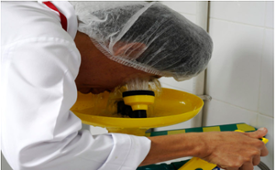
Toxic substance stores must have emergency decontamination facilities located nearby.
Further Storage Requirements
In addition to these risk control measures, there are further requirements for the safe storage of toxic substances. These include:
Dangerous Goods and Safety Signage
To alert staff, supervisors and contractors to the dangerous associated with your chemical store, you must display and maintain the appropriate dangerous goods and safety signage. Your outdoor toxic substance store must have the following signage clearly displayed:
- Dangerous goods diamond – Toxic 6
- Hazard signage – No smoking, no naked flames
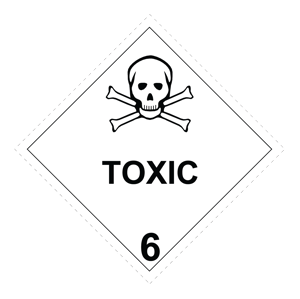
Segregation
When toxic substances are stored in any quantity, they must be housed in a chemical storage container that is installed away from any incompatible substances. Almost every type of dangerous goods must be stored away from incompatible substances with separation distances detailed in the dangerous goods segregation guide.
Toxic substances must be segregated from some dangerous goods classes by a distance of at least 3 metres. The classes which require this 3 metre separation include:
- Class 2.1 Flammable Gas
- Class 3 Flammable Liquids
- Class 4.1 Flammable Solids
- Class 4.3 Spontaneously Combustible
- Class 5.1 Oxidising Agents
- Class 5.2 Organic Peroxides
In addition to these segregation requirements, you must check the SDS of the toxic substance that you're storing to determine segregation requirements for the following DG classes:
- Class 2.2 Non-Flammable, Non-Toxic Gas
- Class 4.1 Flammable Solids
- Class 8 Corrosive Substances
IMPORTANT: If you are storing your dangerous goods in a compliant cabinet or outdoor chemical storage container, the segregation guidelines do not apply. You can safely store toxic substances in a chemical storage container as the store provides the necessary segregation controls.
Separation
Toxic substances must be kept in a store that is installed in a location away from protected places, public places and boundaries of other premises. In Section 4.3 Location of store, the Standard details that the store’s location be away from congested places — so as to protect people, property and the environment in the event of a fire, chemical spill or flood.
The location of store should:
- Avoid close proximity to congested areas such as schools, hospitals and homes
- Avoid proximity to water courses and open stormwater channels
- Located above the highest recorded flood level
- Located away from flammable or combustible materials, so the heat load from a fire will not affect the integrity of the store
Housekeeping
Maintaining good housekeeping practices is essential for toxic substance stores. The store should be designed, constructed and operated in a way that allows for the housekeeping requirements to be carried out effectively. Your store should also allow for the washing down of the floor area, in the event of a toxic substance leak or spill.
Stacking and Loading
Along with maintaining good housekeeping of your toxic chemical store, making sure that your staff know how to stack and load the container is an important factor in risk reduction. You should ensure that the chemical packages are safely stacked in a way that won’t result in collapse and damage to packages.
Customised Outdoor Dangerous Goods Storage
As we’ve highlighted in this blog, toxic substances that are spilt on the skin, splashed in the eyes, or inhaled can cause acute health issues and even fatalities. Due to the high level of risk associated with the handling of these toxic chemicals, your organisation may wish to consider customising your outdoor chemical storage container with additional features.
Some features which can reduce the amount of contact staff must have with the chemical include decanting systems and pumping systems, which may be custom installed on your storage container.
This not only reduces the hazards associated with handling and transferring dangerous goods, it also minimises the likelihood and impact of a chemical spill — which could cause environmental contamination.
Storing Toxic Substances Outdoors?
Due to the serious risks posed by this chemical class, toxic substances must always be handled and stored in a safe, efficient and compliant manner. By installing and maintaining outdoor stores to meet the requirements of AS NZS 4452:1997, you’re taking the essential steps towards creating a safer environment for your people. If you’d like to learn more about outdoor chemical storage, we have a handy checklist that can help. Simply click on the below image today to download your free copy.
Joining the team as a Dangerous Goods Storage Consultant, Melissa Hampton became Storemasta's Marketing Manager in late 2021. With extensive knowledge and experience in chemical compliance, Melissa is responsible for leading the Marketing team and helping shape their marketing strategy. In her spare time, you can find Melissa hiking, swimming and enjoying the great outdoors in beautiful north-west Tasmania.

